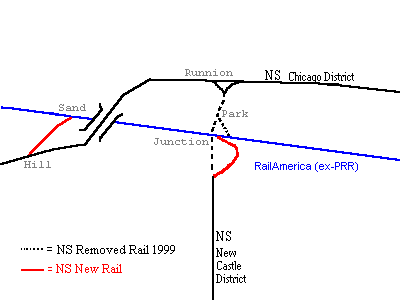In order to solve this problem a project was undertaken between the
City of Fort Wayne and Norfolk Southern. The solution was to reroute
the New Castle District trains onto the Fort Wayne Line (at the time still
NS owned) at Junction and then build one long connecting track to the Chicago
District just west of town. In addition to the New Castle District,
NS would also remove the GR&I track between Park and Junction.
One of the problems this reroute has created for NS is running bi-directional
traffic transferring from the New Castle to the Chicago District and vice
versa. Since the Fort Wayne Line is single track between Sand and Junction,
trains coming north up the New Castle District must now wait at Kingsland
siding for southbound traffic off the Chicago District. Likewise, Chicago
District traffic going south on the New Castle District must wait at Dunfee
siding for northbound New Castle trains. This problem could be alleviated
by installing a crossover just west of Hill and extending the west end
of double track west of Hadley switch. Double-tracking the Fort Wayne Line
from Junction to Sand would be an option, as well.
 This
shows up close what the area looks like today. New Castle District
trains used to transition to and from the Chicago District via Junction
and Runnion, blocking Jefferson Blvd. and Main St. for long periods of
time. Today the new rail at Junction and between Sand and Hill
is used and trains avoid these streets altogether. Trains actually
travel about the same distance as they did traveling through Runnion but
do so much faster. This
shows up close what the area looks like today. New Castle District
trains used to transition to and from the Chicago District via Junction
and Runnion, blocking Jefferson Blvd. and Main St. for long periods of
time. Today the new rail at Junction and between Sand and Hill
is used and trains avoid these streets altogether. Trains actually
travel about the same distance as they did traveling through Runnion but
do so much faster. |
Looking south on the old New Castle District at W. Jefferson Blvd. as Norfolk Southern began the removal process. |
Fort Wayne Navigation Menu:
|
Operations Locations & Interlockings Frequencies Historical Aspects Norfolk Southern's New Route Hotbox Detectors Train Stations |
![]()
© Original Content Copyright 1999-2007
David Safdy
© Design and Updates Copyright 2005-2007
Greg Lavoie
Contacts
Disclaimer